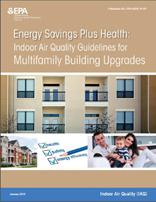 If you are involved in any aspect of multifamily building repair or renovations, including energy or other retrofits or upgrades, these voluntary guidelines will help you ensure that occupant and worker health and safety are protected during and after completion of building modifications. The guidelines will be helpful to federal, state, tribal and local weatherization assistance programs; federally funded housing programs; industry standards organizations; private sector home performance organizations; and other contracting organizations.
If you are involved in any aspect of multifamily building repair or renovations, including energy or other retrofits or upgrades, these voluntary guidelines will help you ensure that occupant and worker health and safety are protected during and after completion of building modifications. The guidelines will be helpful to federal, state, tribal and local weatherization assistance programs; federally funded housing programs; industry standards organizations; private sector home performance organizations; and other contracting organizations.
The Energy Savings Plus Health: Indoor air Quality Guidelines for Multifamily Building Upgrades provide specific assessment protocols for identifying potential indoor air quality issues that could arise during building upgrade work. For each of 24 priority issues, the multifamily guidelines identify critical minimum actions intended to correct deficiencies identified during the assessments, incorporate minimum IAQ protections, and ensure that work does not cause or worsen IAQ or safety problems for occupants or workers (i.e., “Do No Harm”). EPA recommends these protections for all building upgrade projects. Also included are a set of expanded actions to promote healthy indoor environments that can be taken during many building upgrade projects. EPA recommends considering these improvements when feasible and sufficient resources exist.
Users will find valuable guidance organized around 24 specific priority issues, including:
- Environmental tobacco smoke
- Garage air pollutants
- Pests
- Radon
- Heating, ventilation and air conditioning equipment
- Compartmentalization to prevent odor or unwanted air transfer
- Local exhaust
- Mechanical ventilation systems for individual dwelling units
- Mechanical ventilation systems for multiple dwelling units
- Natural (not fan-powered) ventilation systems
- Multifamily building safety
- Protecting IAQ during construction
- Operations and maintenance staff training
- Occupant education
-
Energy Savings Plus Health IAQ Guidelines for Multifamily Building Upgrades (PDF)(101 pp, 2 MB,
January 2016,
EPA 402/K-16-01)
The Energy Savings Plus Health Indoor Air Quality Guidelines for Multifamily Building Upgrades provides practical guidance to ensure healthy indoor environments during mutlifamily residential building upgrades.
-
Preface to Energy Savings Plus Health IAQ Guidelines for Multifamily Building Upgrades (PDF)(1 pg, 37 K,
January 2016)
Acting Assistant Administrator for Air and Radiation Janet McCabe's introduction to the multifamily IAQ guidelines.
